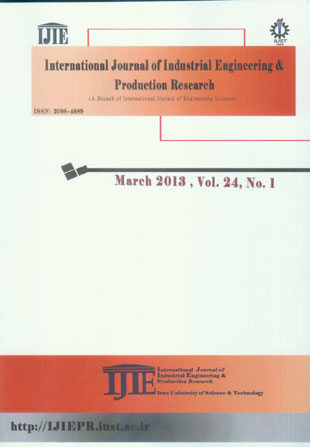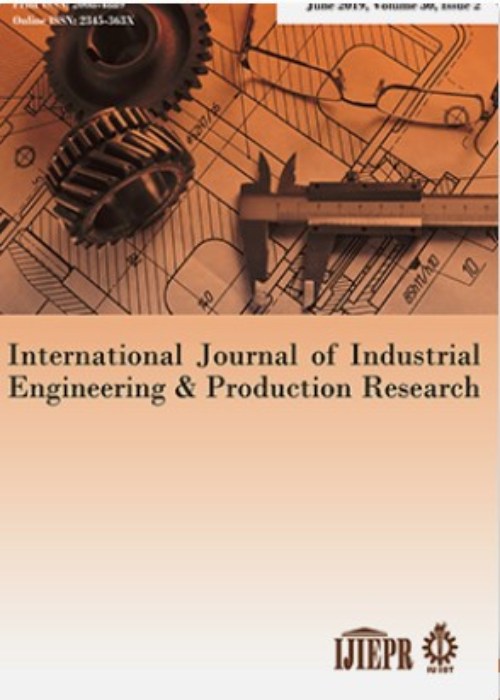فهرست مطالب

International Journal of Industrial Engineering and Productional Research
Volume:24 Issue: 1, Mar 2013
- تاریخ انتشار: 1392/02/25
- تعداد عناوین: 8
-
-
Pages 1-15The existing works considering the flow-based discount factor in the hub and spoke problems, assume that increasing the amount of flow passing through each edge of network continuously decreases the unit flow transportation cost. Although a higher volume of flow allows for using wider links and consequently cheaper transportation, but the unit of flow enjoys more discounts, quite like replacing the current link by a cheaper link type (i.e., increasing the volume of flow without changing the link type would not affects the unit flow transportation cost). Here, we take a new approach, introducing multi-level capacities to design hub and spoke networks, while alternative links with known capacities, installation costs and discount factors are available to be installed on each network edge. The flow transportation cost and link installation cost are calculated according to the type of links installed on the network edges; thus, not only the correct optimum hub location and spoke allocation is determined, but also the appropriate link type to be installed on the network edges are specified. The capacitated multiple allocation p-hub median problem (CMApHMP) using the multi-level capacity approach is then formulated as a mixed-integer linear program (MILP). We also present a new MILP for the hub location problem using a similar approach in order to restrict the amount of flow transmitting through the hubs. Defining diseconomies of scale for each hub type, the model is to present congestion at the hubs and balance the transmitting flow between the hubs. Two new formulations are presented for both the p-hub median and the hub location problems which requiring a flow between two non-hub nodes to be transferred directly, when a direct link between the nodes is available. These models are useful for the general cost structure where the costs are not required to satisfy the triangular inequality. Direct links between non-hub nodes are allowed in all the proposed formulations.Keywords: Hub location, p, hub median, Flow, based discount, Multi, level capacity, Congestion
-
Pages 17-35In the dynamic and competitive market, managers seek to find effective strategies for new products development. Since There has not been a thorough research in this field, this study is based on a review on the risks exist in the NPD process and an analysis of risks through FMEA approach to prioritize the existent risks and a modeling behavior of the NPD process and main risks using system dynamics. First, we present new product development concepts and definition. We then based our study on a literature review on the NPD risks and then provide an FMEA approach to define risks priority. Using the obtained main risks, we model the NPD process risks applying system dynamics to analyze the system and the risks effect on. A safety clothing manufacturer is considered as a case study.Keywords: Product development, Risk analysis, Dynamic Simulation, Systems thinking
-
Pages 37-46This article develops an integrated JIT lot-splitting model for a single supplier and a single buyer. In this model we consider reduction of setup time, and the optimal lot size are obtained due to reduced setup time in the context of joint optimization for both buyer and supplier, under deterministic condition with a single product. Two cases are discussed: Single Delivery (SD) case, and Multiple Delivery (MD) case. These two cases are investigated before and after setup time reduction. The proposed model determines the optimal order quantity (Q*), optimal rate of setup reduction (R*), and the optimal number of deliveries (N*) -just for multiple deliveries case- on the joint total cost for both buyer and supplier. For optimizing our model two algorithm including Gradient Search and Particle Swarm Optimization (PSO), which is a population-based search algorithm, are applied. Finally numerical example and sensitivity analysis are provided to compare the aggregate total cost for two cases and effectiveness of the considered algorithm. The results show that which policy for lot-sizing is leading to less total cost.Keywords: Joint economic lot, sizing (JELS), Setup time reduction, Particle swarm optimization, optimal aggregate total cost
-
Pages 47-58In this paper, we propose an extended relocation model for warehouses configuration in a supply chain network, in which uncertainty is associated to operational costs, production capacity and demands whereas, existing researches in this area are often restricted to deterministic environments. In real cases, we usually deal with stochastic parameters and this point justifies why the relocation model under uncertainty should be evaluated. Albeit the random parameters can be replaced by their expectations for solving the problem, but sometimes, some methodologies such as two-stage stochastic programming works more capable. Thus, in this paper, for implementation of two stage stochastic approach, the sample average approximation (SAA) technique is integrated with the Bender''s decomposition approach to improve the proposed model results. Moreover, this approach leads to approximate the fitted objective function of the problem comparison with the real stochastic problem especially for numerous scenarios. The proposed approach has been evaluated by two hypothetical numerical examples and the results show that the proposed approach can find better strategic solution in an uncertain environment comparing to the mean-value procedure (MVP) during the time horizon.Keywords: Supply chain network, Warehouse relocation, Two, stage stochastic programming, Decomposition methods, Sample average approximation
-
Pages 59-70This paper deals with the problem of forbidden states in discrete event systems modeled by Petri Net. To avoid the forbidden states, some constraints which are called Generalized Mutual Exclusion Constraints can be assigned to them. Enforcing these constraints on the system can be performed using control places. However, when the number of these constraints is large, a large number of control places must be connected to the system which complicates the model of controller. In this paper, the objective is to propose a general method for reducing the number of the mentioned constraints and consequently the number of control places. This method is based on mixing some constraints for obtaining a constraint verifying all of them which is performed using the optimization algorithms. The obtained controller after reducing the number of the control places is maximally permissive.Keywords: Discrete Event System (DES), Supervisory Control Theory, Petri Net (PN), Generalized Mutual Exclusion constraint (GMEC), Flexible Manufacturing System (FMS)
-
Pages 71-80Implementation of the risk management concepts into construction practice may enhance the performance of project by taking appropriate response actions against identified risks. This research proposes a multi-criteria group decision making approach for the evaluation of different alternative response scenarios. To take into account the uncertainties inherent in evaluation process, fuzzy logic is integrated into the revaluation process. To evaluate alternative response scenarios, first the collective group weight of each criterion is calculated considering opinions of a group consisted of five experts. As each expert has its own ideas, attitudes, knowledge and personalities, different experts will give their preferences in different ways. Fuzzy preference relations are used to unify the opinions of different experts. After computation of collective weights, the best alternative response scenario is selected by the use of proposed fuzzy group decision making methodology which aggregates opinions of different experts. To evaluate the performance of the proposed methodology, it is implemented in a real project and the best alternative responses scenario is selected for one of the identified risks.Keywords: Construction industry, group decision making, fuzzy sets, multi, criteria decision making, risk management
-
Pages 81-89Network location models comprise one of the main categories of location models. These models have various applications in regional and urban planning as well as in transportation, distribution, and energy management. In a network location problem, nodes represent demand points and candidate locations to locate the facilities. If the links network is unchangeably determined, the problem will be an FLP (Facility Location Problem). However, if links can be added to the network at a reasonable cost, the problem will then be a combination of facility location and NDP (Network Design Problem); hence, called FLNDP (Facility Location Network Design Problem), a more general variant of FLP. In previous studies of this problem, capacity of facilities was considered to be a constraint while capacity of links was not considered at all. The proposed MIP model considers capacity of facilities and links as decision variables. This approach increases the utilization of facilities and links, and prevents the construction of links and location of facilities with low utilization. Furthermore, facility location cost (link construction cost) in the proposed model is supposed to be a function of the associated facility (link) capacity. Computational experiments as well as sensitivity analyses performed indicate the efficiency of the model.Keywords: Network Location, Network Design Problem, Mixed Integer Programming, Facility Location, Link, Capacity
-
Pages 91-99It was suggested in 2004 by some researchers that it might be possible to improve production systems performance by applying the first and second laws of thermodynamics to reduce system entropy. Then these laws were used to modify the economic order quantity (EOQ) model to derive an equivalent entropic order quantity (EnOQ). Moreover the political instability or uncertainty of a country (as well as the whole world) leads to a much more unstable situation in the present world economy. Thus, changes in inflation take place, and it is needed to consider uncertain inflation rate. In this paper we extend the EnoQ model by considering deteriorating items with imperfect quality and price dependent demand. We also assume fuzzy inflation and discount rates. A mathematical model is developed to determine the number of cycles that maximizes the present value of total revenue in a finite planning horizon. The fuzzified model for inflation and discount rate is formulated and solved by twoMethodssigned distance and fuzzy numbers ranking. Numerical examples are presented and results are discussed. Results show that the number of cycles decreases in fuzzy inflationary conditions. They also illustrate that defuzzification method results in more cycles than fuzzy method.Keywords: inventory, price dependent demand, fuzzy inflation, imperfect items, Thermodynamics laws


